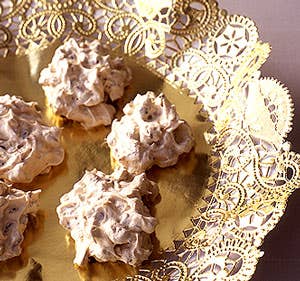
So innocent it looks: a small white mound flecked with bits of dark brown. Made properly, however, this little cookie is a cluster-bomb of flavor. It is also a confection that effortlessly traverses the culinary borders of two very different cultures.
The recipe hails from a small town in Iowa and came west to California in the 1930s with my Methodist grandmother, Helen "Bam Bam" Brown. (Her nickname stems from the way I said "grandma" as a baby.) When I came into the world in the 1950s, Bam Bam's crisp meringue cookies were already part of certain family rituals: Christmas, Thanksgiving, the Fourth of July, and, always, Easter.
And then I married a Jewish woman who not only loved to cook but was very good at it. As fate would have it, I did not make millions with my obscure poetry in the first couple of years of marriage, so we decided to open a small restaurant in San Francisco's Jewish Community Center. Among other things, we did hummus and felafel, chopped liver, blintzes, and—whenever we felt like it—Bam Bam's cookies.
Though this last item is not yet a ubiquitous delicacy on Jewish tables in San Francisco, it's well on its way to becoming one—at least at our house. For starters, if you use nondairy chocolate chips, it is pareve (a "neutral" food according to Jewish dietary law, meaning it may be eaten with either milk or meat products). Even better, because it has no flour—which dietary law forbids during Passover—it is peysadik, or "kosher for Passover". It turns out, as my wife has told me, that meringues have long been considered a perfect Passover treat by both Ashkenazic and Sephardic Jews. What Bam Bam used to call her "forgotten" cookie—because they should be left in the oven overnight to firm up—is the sweet of choice at our seder table as well as at those we visit. The only trouble with these cookies is the forgetting part: Once their aroma fills the kitchen, it's tough to let them slip your mind.
Keep Reading
Continue to Next Story










